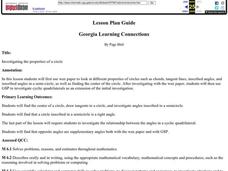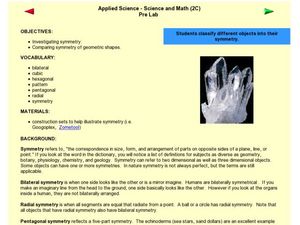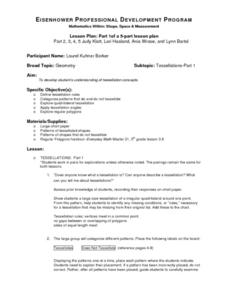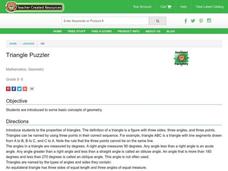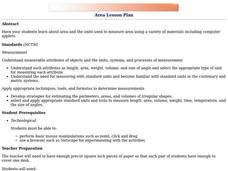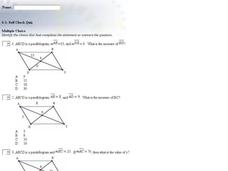Curated OER
Spaghetti Measure
Middle schoolers receive a copy of a "Spaghetti Measure" task sheet along with the scoring rubric. Students preview the task and the rubric prior to starting the task. tudeThey determine the circumference of a circle of spaghetti that...
Curated OER
Making Rectangles
Students study rectangles. In this math lesson, students use numbers, measurements and geometry to draw rectangles of varying sizes.
Curated OER
Investigating the properties of a circle
Learners use wax paper to look at different properties of circles such as chords, tangent lines, inscribed angles, and inscribed angles in a semi-circle, as well as finding the center of the circle, and use GSP to investigate cyclic...
Curated OER
BASEBALL HOME RUN
Students determine whether a hit baseball is a home run or not by utilizing parametric equations to describe the path of the ball. They assess the importance of angles and velocity needed to hit a home run. In addition, in their own...
Curated OER
Origami Frogs
Ninth graders explore a variety of geometry and science concept while making an origami frog. The fold paper into the shape of a frog and conduct measurement activities including frog leaps.
Curated OER
Symmetry
Sixth graders explore symmetry and discuss the difference between a rotation and reflection. Using hands-on activities, such as folding paper shapes, they discover how to find the lines of symmetry and symmetrical characteristics. As a...
Curated OER
What's Your Latitude?
Learners measure the height of items using an astrolabe. In this latitude lesson students construct a sextant and determine height and latitude with it.
Curated OER
Geometry /Tessellations
Students investigate the concept of tessellations and how they are formed using angles. They categorize how different patterns do and not tessellate and separate them into two different places for assessment. The teacher draws examples...
Curated OER
Got Complements? with Cabri Jr.
Learners use the axes and measure angle tool to explore and calculate complementary angles with Cabri Jr. They also identify what happens to the calculation as they drag the endpoint into a different quadrant. Finally, they label each...
Curated OER
Triangle Puzzler
Students are introduced to some basic concepts of geometry. They explain that the definition of a triangle is a figure with three sides, three angles, and three points. Triangles can be named by using three points in their correct sequence.
Curated OER
Area Lesson Plan
Students explore geometry by using computer applications. In this spatial measurement lesson, students discuss the difference between area, weight, volume and other forms of measurement. Students utilize computer applications to find the...
Curated OER
Trigonometry in Action
Students examine how to apply the principles of trigonometry in authentic measurement situations. They work in groups to determine the height of an object such as a flag pole by determine the angle from their position to the top.
Curated OER
Light Bounce
Students solve problems involving triangles. In this geometry lesson, students apply properties of triangles to find the missing angles and sides. They identify angles of parallel lines cut by a transversal.
Alabama Learning Exchange
It's Around There Somewhere! Perimeter, and Circumference
Explore the concept of building equations for perimeter and circumference. Learners use rulers to measure the perimeter of half a sheet of paper. Then fold the sheet of paper numerous times, each time measuring perimeter. ...
Curated OER
3D Objects
In this math worksheet, students solve six problems about 3D objects. Students also solve six problems about measuring 3D objects.
Curated OER
Trapezoids
In this trapezoids worksheet, 10th graders solve 5 different problems related to trapezoids and applying the appropriate theorem. First, they define a trapezoid, including its bases, legs, and base angles. Then, students use the...
Curated OER
Are you in Golden Shape
Young scholars solve and verify the solution for unknown measures. In this geometry lesson, students identify the properties of circles. They use the arc, angle and segment relationship to find the missing measures.
Curated OER
Taller/Wider/longer
In this unit, 1st graders use measurement language and counting to compare objects in a variety of game situations. Students also practice the advanced concept of counting to advanced counting.
Curated OER
Challenge: Skills and Applications Lesson 3.4
In this geometry activity, students identify the missing angles formed by parallel lines and a transversal. They differentiate between parallel and perpendicular lines. There are four questions.
Curated OER
Pythagorean Theorem: Triangles and Their Sides
Pupils investigate triangles and their relationship to each other. In this geometry lesson, students solve right triangles using the properties of the Pythagorean Theorem. They differentiate between right, acute, straight and oblique...
Curated OER
Geometry Involving Figures - Week 12 (Ratio and Surface Area)
In this ratio and surface area worksheet, students find the ratio of surface area of one figure to another. They determine the length of sides and angles through similar figures. Students use trigonometric ratios to find the length of...
Curated OER
Identify Similar Triangles With Proofs
In this similar triangle worksheet, students write a two-column proof to explain why determined triangles are similar. Given some line lengths and angle measurements, students use proofs to identify the ratio of specified angles. This...
Curated OER
A Blast of Math
In this math review worksheet, students complete several activities that help them review fractions, writing dates, position terms, reading clocks, finding distance, finding angles, and several other review items.
Curated OER
Parallelograms Multiple Choice
In this geometry worksheet, students calculate the different measurements for parallelograms using the properties of quadrilaterals. They are given partial information and must solve the problem. There are 6 questions with an answer...
Other popular searches
- Measuring Classifying Angles
- Measuring Interior Angles
- Measuring and Drawing Angles
- Measuring Reflex Angles
- Measuring Triangle Angles
- Measuring Central Angles
- Measuring Inscribed Angles
- Measuring Polygons Angles
- Measuring Segments and Angles




